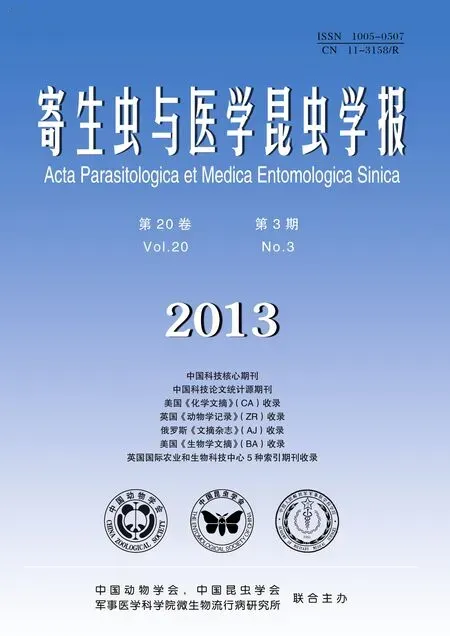A NEW SPECIES OF SIMULIUM(SIMULIUM) FROM HE’NAN PROVINCE, CHINA(DIPTERA:SIMULIIDAE)
GUO Xiao-Xia YAN Ge AN Ji-Yao
(State Key Laboratory of Pathogen and Biosecurity, Beijing Institute of Microbiology and Epidemiology, Beijing 100071, China)
Abstract A new species, Simulium (Simulium) nanyangense sp. nov. is described based on the female, and pupal stages, specimens collected from Nanyang, He’nan Province, China. It is assigned to the malyschevi-group of the subgenus Simulium, and is closely related to S. (S.) jacuticum Rubtsov,1956, S. (S.) hirtipannus Puri, 1932 and S. (S.) spiculum Chen, Huang et Yang, 2010. However it is clearly differentiated from them by the claws simple in the female and cocoon without window.
Key words Diptera; Simuliidae; Simulium (Simulium); New species
Previous paper (Lietal., 1998) reported three species, that is,Simulium(Simulium)bidentatumShiraki,1935,Simulium(Simulium)hirtipannusPuri, 1932 andSimulium(Simulium)quinguestriatum(Shiraki, 1935) from Baotianman Nature Reserve, Nanyang, He’nan Province, China. In this paper, the authors reports a new species of SubgenusSimuliumLatreille,S. (Simulium)nanyangensesp. nov. occurring in the same distribution area. The morphological description and taxonomic discussion are given below. All the specimens are kept in the Collection of Medical Entomology, Beijing Institute of Microbiology and Epidemiology.
Simulium(Simulium)nanyangensesp.nov.(Figs.1-7)

Figs. 1-6 Simulium (Simulium) nanyangense sp.nov. 1.Genitalia (ventral view);2. Cibarium; 3.3rd segment of maxillary palp; 4. Hind basitarsus and 2nd tarsal segment; 5. Claw; 6. Pupal gill filaments; 7. Lateral view of cocoon.
Female. Body about length 2.6 mm. Wing length 2.2 mm. (Figs. 1-5)
Head. Slightly narrower than width of thorax. Frons and clypeus brownish black, with slivery grey pollinosity covered several brownish black hairs. Frontal ratio 40:30:30. Frons-head ratio, 40:100. Antenna composed of 2+9 segments, brownish black except scape and pedicel brownish yellow. Maxillary palp composed of 5 segments, proportional lengths of 3rd, 4th and 5th segments are in the ratio of 18:21:36; and 3rd segment somewhat swollen, with sensory vesicle similar round about 1/3 times as long as 3rd segment (Fig.3). Maxilla with 10 inner and 12 outer teeth. Mandible with 32 inner and 26 outer teeth; Cibarium armed with minute tubercle(Fig.2).
Thorax. Scutum, brownish black, densely covered with golden yellow recumbent pubescence; Scutellum brownish black with several erect dark hairs posteriorly; Postscutellum brownish black, whitish grey pruinose, bare. Pleural membrane and katepisternum bare.Legs: All coxae brownish yellow except mid and hind coxae brownish black. All trochanters brownish yellow. All femora brownish yellow except fore femora on apical 1/3, mid femora on apical 1/3 and hind femora on apical 1/3 brownish black; All tibiae brownish black except fore tibia on distal 1/3, mid tibia with outer median portion largely brownish yellow and hind tibia with outer median portion largely brownish yellow. All tarsi brownish yellow except fore tarsus, mid basitarsus on distal 1/3, 2nd tarsomere on distal 1/2, hind basitarsus on distal 1/4, 2nd tarsomere on distal 1/2 brown black. Calcipala developed, about 0.6 times as long as width of basitarsal tip; Pedisulcus distinct about basal 1/3 of 2nd tarsal segment(Fig.4). Claws simple (Fig.5). Wing: Costa with spinules as well as hairs; subcosta with 3 root haired on basal 1/5.
Abdomen. Basal scale, black with fringe of blownish black hairs; dorsal surface of abdomen brownish black; Sternite 8 bare medially, with 12 thick hairs on each side. Anterior gonapophyses widely separated, shape like a knife, broadly rounded on inner posterior border end, each with 7 hairs and numerous microsetae. Genital fork of inverted-Y form, with well sclerotized stem and arms; arm with stout outer projection of distal section on each arm(Fig.1). Paraproct in ventral view, horizontal wide, ellipse shape, with moderately setose and numerous microsetae (Fig.1). Cercus circular cone shaped, with many moderately setose and numerous microsetae (Fig.1). Spermatheca similar round, strongly sclerotized with reticulate pattern.
Pupa. Body length 2.5 mm. Gill filaments length 2 mm(Figs. 6-7).
Head and thorax. Integument, yellow, densely covered with tubercles. Gill with 6 thick filaments, arranged in groups of 2, 2, 2; with short stalks.
Abdomen. Tergum 2, with 2 thin and 1 thick, spines setae on each side. Terga 3 and 4 with 4 hooked spines along posterior margin on per side; Terga 6-8 each with two hooked spines along posterior margin on each side. Tergum 9 each with a transverse row of spine-scale on each side.
Cocoon
Simple, wallpocket-shaped, moderately woven, extending ventrolaterally, anterior margin somewhat thickly woven. Cocoon without window.
Type specimens. Syntype 1♀,slide-mounted, together with its pupal skin and cocoon on glass slide. Reared from 1 pupa collected in a small shaded stream from Baotianman Nature Reserve(33.1°N, 111.7°E) about 100 m, Nanyang district, He’nan Province, China. June 10,1994, AN Ji-Yao and GUO Wei.
Male and Mature larva. Unknown.
Distribution. the Baotianman Nature Reserve, Hanyang district,He’nan Province, China.
Remarks. According to the shape of the female and the characters of pupa, the present new species belongs to the themalyschevi-group of the subgenusSimuliumas defined by Rubtsov (1959-1964) and Crosskey (1987).
This new species seems to most closely resembleS. (S.)jacuticumRubtsov 1940 from Russia,S. (S.)hirtipannusPuri, 1932 from Indian,S. (S.)spiculusChen, HuangetYang, 2010 from China, in the shapes of anterior gonapophysis, genital fork, number of the pupal filaments. However, it is clearly differentiated from them by the ventral surface of the 7th stemite without a patch of branched long setae, claws simple, and cocoon without window.

